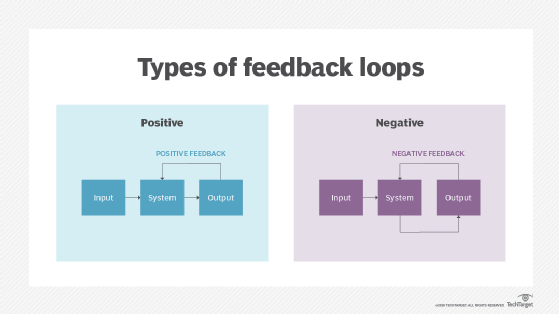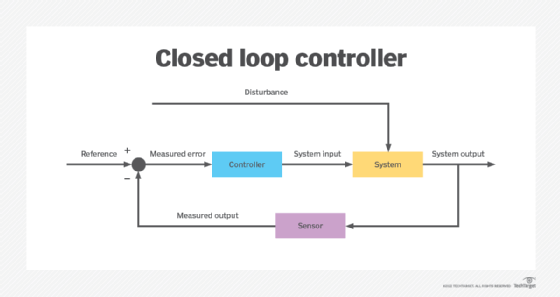feedback loop
What is a feedback loop?
A feedback loop is the part of a system in which some portion (or all) of the system's output is used as input for future operations. Each feedback loop has a minimum of four stages. During the first stage, input is created. During the second stage, input is captured and stored. During the third stage, input is analyzed and during the fourth stage, the insight gained from analysis is used to make decisions.
Feedback loops can be applied in various contexts, including customer feedback, employee feedback, climate systems and biological processes.
Positive vs. negative feedback loop
Feedback loops can be either negative or positive. The following are the distinct characteristics and effects of these two types of feedback loops:
Negative feedback loops
Negative feedback loops are self-regulating and useful for maintaining an optimal state within specific boundaries. An old-fashioned house thermostat that uses a bang-bang (on-off) control system to turn a furnace on or off is a classic example of a self-regulating negative feedback loop. When the temperature drops to a predetermined low set point, the thermostat switches the heating system on. When the temperature reaches a predetermined high set point, the thermostat switches the heating system off.
Negative feedback loops are known for being stable, but not especially accurate. For example, in the case of a home thermostat, there can be a fairly wide range of acceptable temperatures that can cause the heating system to have a fairly long response time.
Positive feedback loops
In contrast, positive feedback loops simply repeat actions that have been effective in the past. A positive feedback loop intends to amplify a desired variable and naturally move the system from its starting state to a desired state. A good example of a positive feedback loop is the melting of polar ice caps. As ice melts, it reduces the Earth's albedo or reflectivity, which in turn leads to more heat being absorbed by the Earth, further melting ice and causing more warmth.
However, problems can occur when the positive feedback loop grows exponentially without any checks or balances. In such a scenario, a runaway positive feedback loop can make a system unstable.

Uses for feedback loops in different industries
Feedback loops are an important aspect of closed loop control systems. They can be applied to a variety of different fields, including the following:
- Biology. In biology, feedback loops help organisms maintain balance in different life cycles. More specifically, within the human body, feedback loops include internal temperature regulation and healing.
- Computer science. In computer science, a feedback loop refers to an endless loop of instructions that can be given to a computer that has no final step.
- Software development. In software development, feedback loops are used on programs to detect potential problems or defects within the code.
- Psychology. In psychology, professionals study the effect of feedback loops that cause patients to fall into cyclical thinking. An example could be a person's feelings leading up to an important event. Anxiety or fear might negatively affect the event itself whereas confidence might result in the opposite effect.
- Economics. In economics, an example of a feedback loop is a company that reinvests sales revenue to generate even more income.
- Customer experience. In customer experience, a customer feedback loop refers to a business strategy where product developers use customer opinion to determine future actions.
- Marketing. In marketing, social media can be used as a feedback loop to improve marketing techniques. For example, measuring the types of content that have the highest levels of engagement can help marketers know which content to pursue in the future.
- Project management. Project managers in various industries, such as construction, use feedback loops to collect stakeholder feedback on the progress of projects. This feedback is then used to make necessary changes to the timeline, budget and resources.
- Artificial intelligence and machine learning. AI and machine learning utilize feedback loops, such as backpropagation algorithms, to identify inconsistencies and feed corrected information back into the model as input. This constant adjustment through feedback loops enables AI to learn from its mistakes and improve its accuracy.

Examples of positive feedback loops
A positive feedback loop is a biological phenomenon that occurs when a system's output increases and pushes the system farther from equilibrium.
Here are some examples of positive feedback loops:
- Blood clotting. One positive feedback loop example is the process of blood clotting, also known as coagulation. As one clotting factor activates, it continues to activate others in a sequence until a clot, fibrin, is formed.
- Childbirth. During labor, the stretching of the cervix beyond its normal position initiates contractions, which are then amplified in strength and frequency until the baby is born.
- Audio feedback. Audio feedback, also known as acoustic feedback, is a special kind of positive feedback that occurs when a sound loop exists between an audio input and an audio output, resulting in an amplified signal.
- Fruit ripening. In nature, a tree or bush might suddenly ripen all of its fruit or vegetables without any visible signal. This is an example of a positive biological feedback loop.
- Financial markets. In financial markets, a speculative bubble is an example of a positive feedback loop. As asset prices rise, investors see potential profits and continue to buy, driving prices even higher. This can create a bubble until the market eventually corrects itself.
Examples of negative feedback loops
Negative feedback loops are feedback mechanisms that help maintain stability or homeostasis by dampening or counteracting changes.
Here are some examples of negative feedback loops:
- Blood glucose regulation. Blood glucose levels rise after eating. This rise triggers the release of insulin, which helps cells absorb glucose for cellular energy production. To keep blood sugar levels from falling too low, insulin release also falls when glucose levels do. Blood glucose is kept within a specific range with the aid of this negative feedback loop.
- Osmoregulation. Fish living in the ocean exhibit osmoregulation, which is a negative feedback loop. Water with a higher salt content enters the fish through its gills and is ingested because saltwater has a higher salt concentration than the fluids inside the fish. Thus, as water leaves the fish, salt diffuses passively inside. Mechanisms such as concentrated urine production and salt outflow through the skin are triggered by excess salt. The gills' specialized cells actively remove extra salt from the bloodstream. These mechanisms preserve the fish's salt equilibrium, illuminating the negative feedback loop of osmoregulation.
- Climate regulation. Increased atmospheric carbon dioxide levels lead to warmer temperatures due to the greenhouse effect. However, higher temperatures also accelerate processes such as photosynthesis and weathering, which remove carbon dioxide from the atmosphere over long periods. As carbon dioxide levels decrease, the greenhouse effect weakens, leading to cooler temperatures and global warming. This negative feedback loop helps regulate Earth's climate.
- Regulation of blood calcium levels. The regulation of blood calcium levels is also another example of a negative feedback loop. Parathyroid hormone, which is secreted by the parathyroid glands, controls blood calcium levels. If blood calcium increases too much, the parathyroid glands reduce parathyroid hormone production, demonstrating a negative feedback mechanism.
How to create a feedback loop
Feedback loops play an integral role in customer service and business processes. Creating a feedback system involves several key steps to ensure that feedback is collected, analyzed and acted upon effectively.
Here are the essential steps involved in creating a feedback loop:
- Collect feedback. The first step in creating a feedback loop is to actively gather feedback from customers, employees or other relevant stakeholders. This can be achieved through surveys, market research, in-app feedback forms, or direct communication with customers and employees.
- Analyze feedback. Once the feedback is collected, it needs to be carefully analyzed to identify customer complaints, patterns and areas for improvement. This analysis helps in understanding the specific issues and opportunities for improving the customer experience, business processes and product quality.
- Acknowledge feedback. It's important to acknowledge the received feedback, whether it's positive or negative. Acknowledgment demonstrates that the feedback is valued and encourages continued participation in the feedback process.
- Execute the findings. After analyzing the feedback, actionable steps for improvement should be identified and enforced. This may involve making changes to products, services, or internal processes based on the insights gained from the feedback.
- Inform stakeholders. The final step in the feedback loop is to inform the stakeholders, such as customers or employees, about the changes that have been conducted as a result of the feedback received. This communication is crucial for demonstrating that their feedback has been heard and acted upon.
Feedback loop best practices
Here are some best practices that businesses can use for managing and creating effective feedback loops:
- Segment users for insights. Businesses should perform customer segmentation before collecting feedback for more meaningful conclusions. Specific groups, such as power users, should be targeted with relevant surveys for feature enhancements and actionable insights.
- Close the loop efficiently. Businesses should quickly respond to customer survey feedback, resolve pain points and assure customers that their insights are the driving factors behind product and service improvements. Assured customers are happier and can lead to increased revenue and retention rates.
- Use feedback for improvement. Customer feedback should be turned into product and service enhancements, fostering positive feedback loops. Actively addressing feedback is vital for maximizing customer interactions.
- Establish closed-loop systems. Businesses must prioritize customer journey and experience if they wish to stand out in a competitive market. This can be achieved by understanding and addressing the concerns raised by customer surveys.
Gaining an understanding of customer feedback is crucial for organizations to identify issues, improve product offerings and increase customer satisfaction levels. Find out what kinds of feedback customers can provide and five efficient ways to collect it.






